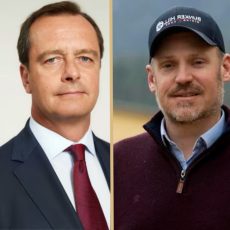What prompted the decision to restart mining at Bunker Hill?
S.A.: Bunker Hill is a historic Zinc-Silver-Lead mine that operated continuously for 90 years until 1981 - yet still retains a fantastic mineral endowment. After the mine and its smelter was closed for its failure to comply with the strict new environmental laws passed in the 1970's, the mining area was remediated by the Environmental Protection Agency and the local community was left socio-economically abandoned.
Since the 1980s, the U.S. has increasingly relied on metals sourced from around the world, but is now looking to source these essential metals from more secure, local and sustainable operations. One way to do that is to take another look at the potential old mines like Bunker Hill still have to contribute, and if they can be restored to commercial production in ways that meet modern standards of management.

At Bunker Hill, we are demonstrating that mine rejuvenation is both profitable and sustainable. We’re communicating to the capital markets that an investment to reopen mines like Bunker Hill offers superior ROI, whilst also enhancing the local economy and increasing the US domestic supply of critical metals.
If these resources are untapped, why was the mining site overlooked by the major players of the industry?
S.A.: Besides regulatory challenges and potential technical issues, to be successful at a project like this, your company must be well-integrated within the local community, and this takes a lot of empathy, commitment and presence. In addition, when getting involved in a regeneration project, one must also be ready to take on and resolve liability, which sometimes comes bundled with historic sites. Most of the major mining companies are put off by the challenges: the need to start small and then scale up, as well as the constancy of commitment required.
What is different in the operation of a mine which is reopening compared to one which is freshly discovered?
S.A.: Operating on a former site allows us to leverage the existing infrastructure and historical data, as well as any existing mining permits. The other so-called ‘sunk costs’ are left to us. This can ensure a lower initial capital outlay and a faster route to cash-flow, thereby allowing us to deliver significant financial returns very quickly.. This is all magnified by the application of modern mining and processing techniques, which were not available to previous owners of the site, which means these sites can be brimming with economic potential.
How much appetite is there for investment into mine rejuvenation compared to other projects you have worked on in the past?
S.A.: Even with all the advantages I have described, we are finding that both the traditional funds and the new impact (or ESG) funds are still nervous about investing in rejuvenation. This is due to the initially small scale of resources contained within these projects, relative to those being developed by explorers in greenfield sites. The larger the project, the more attention and capital is attracted to it - particularly at a time when the total amount of the capital available for the mining industry is so small, and what is available is so expensive. However, we believe this will change, because our low-cost, rapid restart of old mines will demonstrate rates of returns on investment that are far superior to many of the large, slow-to-develop, and very expensive projects out there.
What challenges are the global mining industry facing right now?
R.W.: The dominant challenge is the general lack of financial capital available at the right price, particularly for junior explorers and developers. We simply aren’t exploring enough. We aren’t building enough mines. This is compounded by a scarcity of human capital - the skilled workers, and leaders - as well as lengthy permitting timelines for new projects.
Put simply, the mining industry lacks sufficient money, people and permissions to meet the needs of the world. There is a long-held, but outdated view, that mining is dirty, old-fashioned, polluting and dangerous industry. Hence, the industry must work diligently to operate differently. We need to invest in human talent and enhance the quality of the environment and economies that surround mining. This is our North Star at Bunker Hill: we are working hard to improve the image and the output of our vital industry at a critical time.
When mines shut, nearby towns are often left without a local economy. Does Bunker Hill have continuity plans in place?
S.A.: For the last 40 years, the Federal Government and the EPA have successfully rehabilitated the environment around our mine. We plan to continue to carry that impressive legacy forward, ensuring no environmental damage. Concurrently, we’ll be creating 250 direct jobs and 1250 indirect jobs for the local community, and we’ll catalyse other non-mining investment in the area.
This will be a long-term business, possibly over 40 more years, which creates significant local wealth and opportunity for the community. As post-closure goes, we will follow best practice. When Bunker Hill closed down, a new businesses that started in the Silver Valley was The Silver Mountain Ski Resort, on the mountain directly above the mine. Support for entrepreneurship like this helps to diversify local economies post-closure, and enables sustainable livelihoods within areas of outstanding natural beauty.
R.W.: Mining the way we do it generates wealth for local people, as well as the domestic supply of mineral resources for their country. We actively seek out ways to multiply our local economic impact. Our company and our partners are willing to invest in local, non-mining business opportunities to ensure this. Looking to the future four decades from now when Bunker Hill shuts down, the Silver Valley will still be a prosperous area where people work or come to retire, and can enjoy the outdoors by hiking, fishing or skiing .
You have both been executives at one of the most famous mining companies in the world. What would you like to do differently in terms of management at Bunker Hill?
R.W.: Building upon the best practices observed at Barrick, we emphasize at Bunker Hill the vital role that effective, front-line corporate leadership plays in ensuring optimal mining performance. Teamwork and talent management are at the heart. Even with all the technology, science and equipment, mining first and foremost a human business. The success or failure of a mine depends upon the quality, motivation, and inspiration of its employees.
It’s all about the culture and ethos - if you get that right, then risk management and opportunity development comes with ease. Get it wrong, and you never get out of the penalty box. So at Bunker, as with other mining companies, we are building a people-centric, disciplined yet entrepreneurial, creative culture from scratch. We are driven to deliver the highest possible quality of leadership and teamwork - that’s ambitious, but we’ve done it before and so our investors know we can get the job done.
S.A.: Bunker Hill presents an opportunity to demonstrate the role of mining in revitalizing the regions of America that have suffered from misaligned economic and industrial change over the last 100 years. We believe that mining will make-up the difference. We can bolster security within the national supply chain of critical metals at the same time as creating much-needed jobs and economic opportunities. As well as significant profits for our investors, Bunker Hill is making a remarkable and positive impact in a place where it’s really needed - that’s worth every bit of our effort and expertise.





